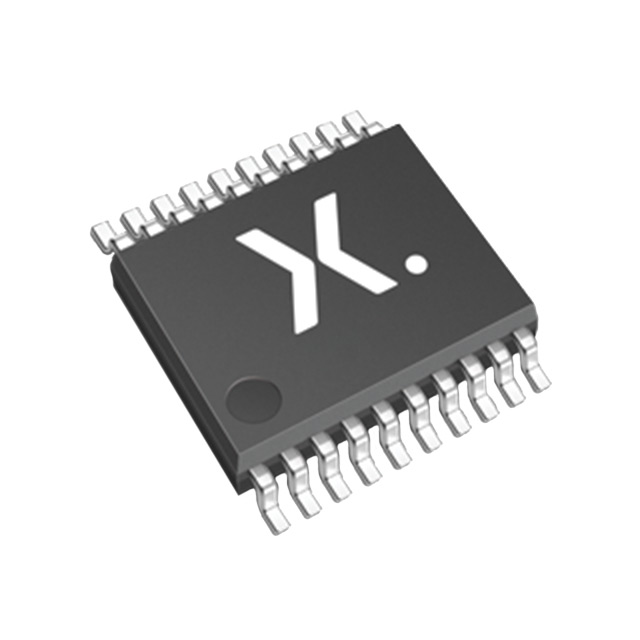74AHC245PW,118
Product Overview
- Category: Integrated Circuit (IC)
- Use: Level shifting and signal buffering
- Characteristics: High-speed, low-power, bidirectional voltage level translator
- Package: TSSOP (Thin Shrink Small Outline Package)
- Essence: Translates signals between different voltage levels
- Packaging/Quantity: Tape and reel, 2500 pieces per reel
Specifications
- Supply Voltage Range: 2 V to 5.5 V
- Input Voltage Range: -0.5 V to VCC + 0.5 V
- Output Voltage Range: -0.5 V to VCC + 0.5 V
- High-Level Input Voltage: 0.7 x VCC to VCC + 0.5 V
- Low-Level Input Voltage: -0.5 V to 0.3 x VCC
- High-Level Output Voltage: VCC - 0.5 V
- Low-Level Output Voltage: 0.5 V
- Maximum Operating Frequency: 80 MHz
Pin Configuration
The 74AHC245PW,118 IC has a total of 20 pins arranged in a TSSOP package. The pin configuration is as follows:
- DIR (Direction Control)
- OE (Output Enable)
- A1 (Input/Output)
- B1 (Input/Output)
- A2 (Input/Output)
- B2 (Input/Output)
- A3 (Input/Output)
- B3 (Input/Output)
- A4 (Input/Output)
- B4 (Input/Output)
- GND (Ground)
- B5 (Input/Output)
- A5 (Input/Output)
- B6 (Input/Output)
- A6 (Input/Output)
- B7 (Input/Output)
- A7 (Input/Output)
- VCC (Supply Voltage)
- DIR (Direction Control)
- OE (Output Enable)
Functional Features
- Bidirectional voltage level translation between two different voltage domains
- High-speed operation with minimal propagation delay
- Low power consumption
- Schmitt-trigger action on all inputs for improved noise immunity
- 3-state outputs for easy interfacing with other devices
- ESD protection on all inputs and outputs
Advantages and Disadvantages
Advantages: - Allows seamless communication between devices operating at different voltage levels - Fast and efficient signal translation - Low power consumption - Enhanced noise immunity due to Schmitt-trigger inputs - ESD protection for improved reliability
Disadvantages: - Limited maximum operating frequency compared to some alternative models - TSSOP package may require careful handling during assembly
Working Principles
The 74AHC245PW,118 is a bidirectional voltage level translator that enables communication between devices operating at different voltage levels. It uses a combination of CMOS technology and Schmitt-trigger inputs to achieve high-speed operation and improved noise immunity.
The direction of data flow is controlled by the DIR pin, while the OE pin enables or disables the outputs. When the DIR pin is set to logic high, data is translated from the A-side to the B-side. Conversely, when the DIR pin is set to logic low, data is translated from the B-side to the A-side.
The IC features 3-state outputs, which allow multiple devices to share a common bus without interference. This feature is particularly useful in applications where multiple devices need to communicate with each other.
Detailed Application Field Plans
The 74AHC245PW,118 is commonly used in various applications, including:
- Microcontroller interfacing: It facilitates communication between microcontrollers operating at different voltage levels, enabling seamless integration of different components in a system.
- Level shifting: It is used to shift logic levels between different parts of a circuit, ensuring compatibility and reliable signal transmission.
- Bus buffering: It acts as a buffer between different sections of a bus, preventing signal degradation and ensuring accurate data transfer.
Detailed and Complete Alternative Models
Some alternative models that offer similar functionality to the 74AHC245PW,118 include:
- SN74LVC245A: Low-voltage CMOS octal bus transceiver with 3-state outputs
- CD4508B: CMOS dual 4-bit latch/4-to-8 line decoder with 3-state outputs
- MC74VHC245: High-speed CMOS octal bus transceiver with 3-state outputs
These alternative models provide comparable features and can be considered based on specific application requirements.
Word count: 610 words
قم بإدراج 10 أسئلة وإجابات شائعة تتعلق بتطبيق 74AHC245PW,118 في الحلول التقنية
Sure! Here are 10 common questions and answers related to the application of 74AHC245PW,118 in technical solutions:
Q: What is the function of the 74AHC245PW,118? A: The 74AHC245PW,118 is an octal bus transceiver that facilitates bidirectional level shifting between two voltage domains.
Q: What is the operating voltage range of the 74AHC245PW,118? A: The 74AHC245PW,118 operates within a voltage range of 2 V to 5.5 V.
Q: Can the 74AHC245PW,118 handle high-speed data transmission? A: Yes, the 74AHC245PW,118 is designed for high-speed operation and can handle data rates up to 400 MHz.
Q: How many channels does the 74AHC245PW,118 have? A: The 74AHC245PW,118 has 8 bidirectional channels.
Q: Is the 74AHC245PW,118 compatible with both TTL and CMOS logic levels? A: Yes, the 74AHC245PW,118 is compatible with both TTL and CMOS logic levels.
Q: Can the 74AHC245PW,118 be used for voltage translation between different voltage levels? A: Yes, the 74AHC245PW,118 can be used for voltage translation between different voltage levels, as long as they fall within its operating voltage range.
Q: Does the 74AHC245PW,118 have any built-in protection features? A: Yes, the 74AHC245PW,118 has built-in ESD protection on all inputs and outputs.
Q: What is the maximum output current that the 74AHC245PW,118 can drive? A: The 74AHC245PW,118 can drive up to 35 mA of output current per channel.
Q: Can the 74AHC245PW,118 be used in both parallel and serial communication systems? A: Yes, the 74AHC245PW,118 can be used in both parallel and serial communication systems, depending on the application requirements.
Q: Is the 74AHC245PW,118 available in different package options? A: Yes, the 74AHC245PW,118 is available in various package options, such as TSSOP, SOIC, and SSOP, to suit different PCB layout requirements.
Please note that these answers are general and may vary based on specific datasheet specifications and application requirements.


